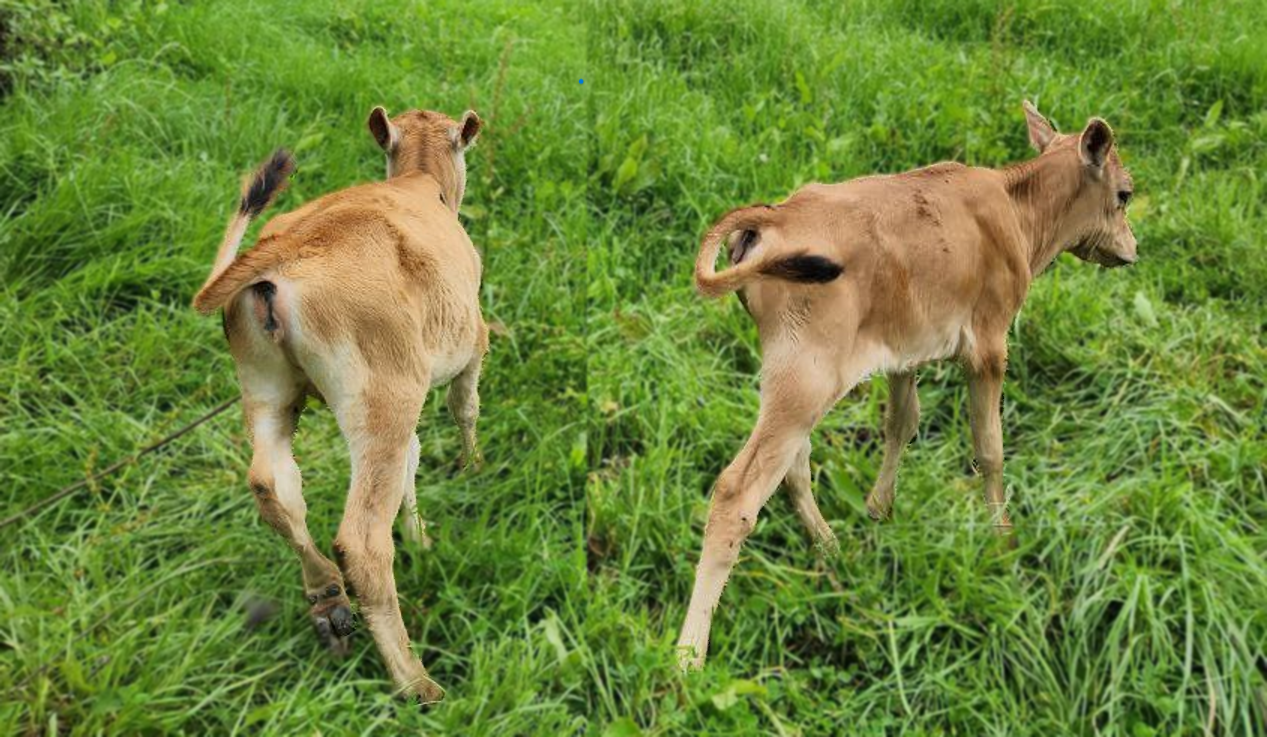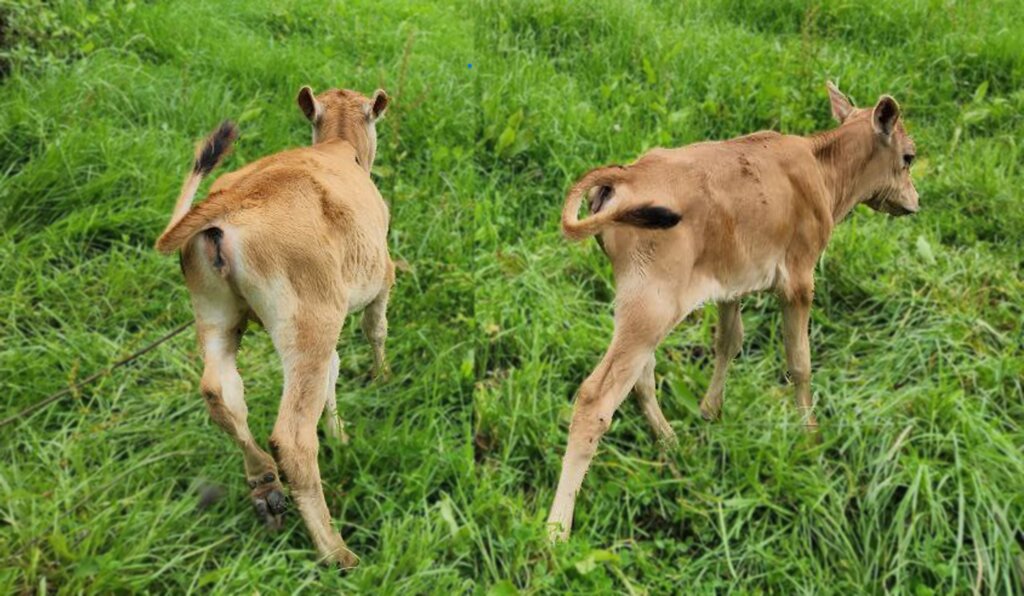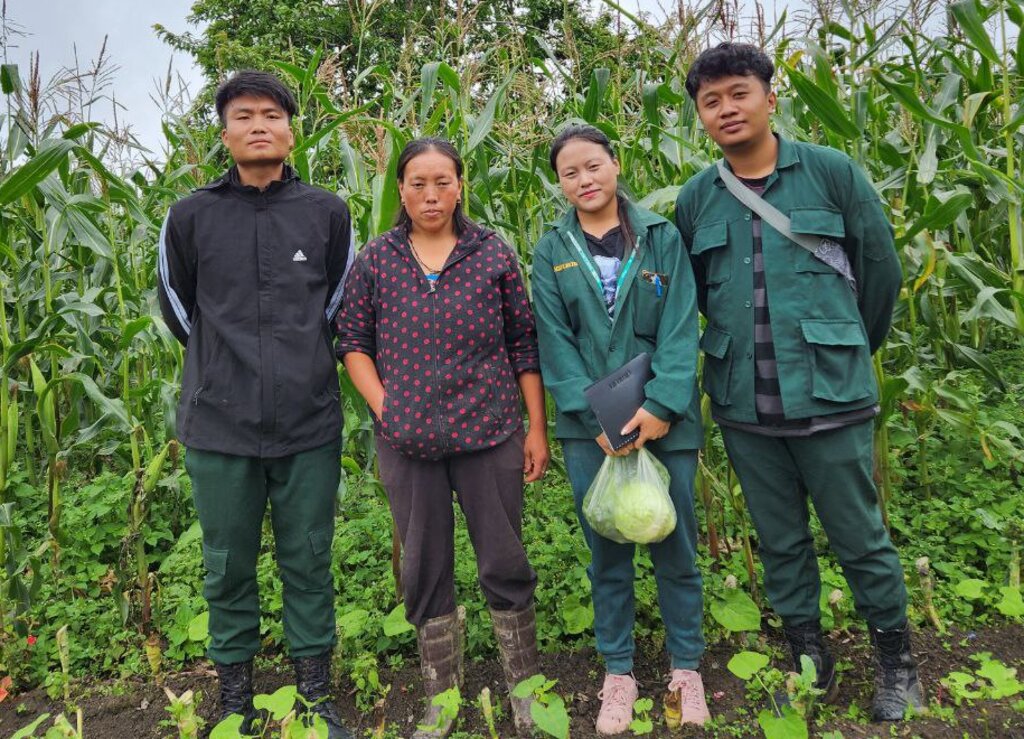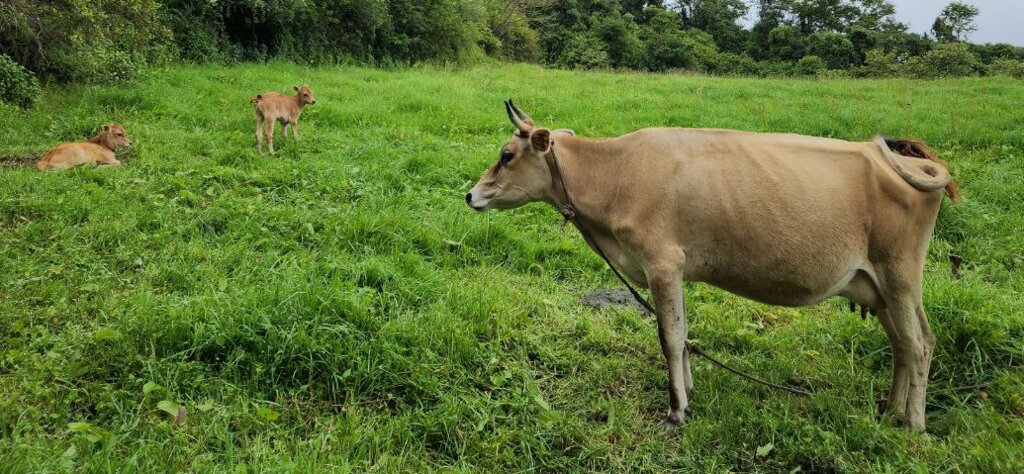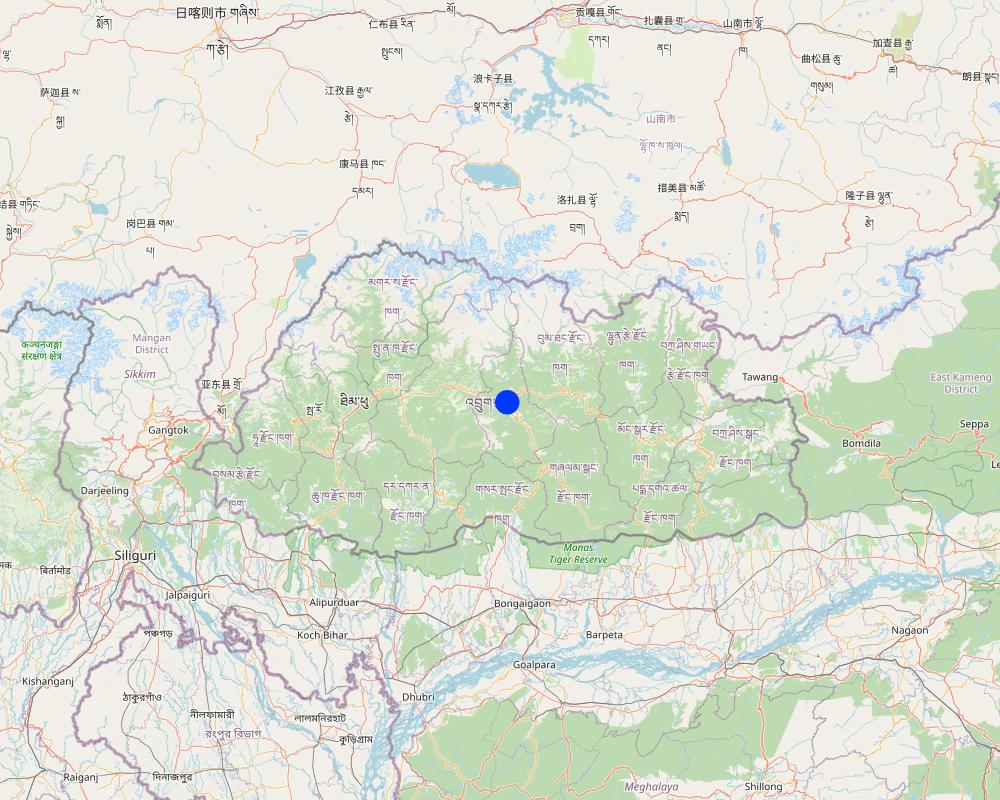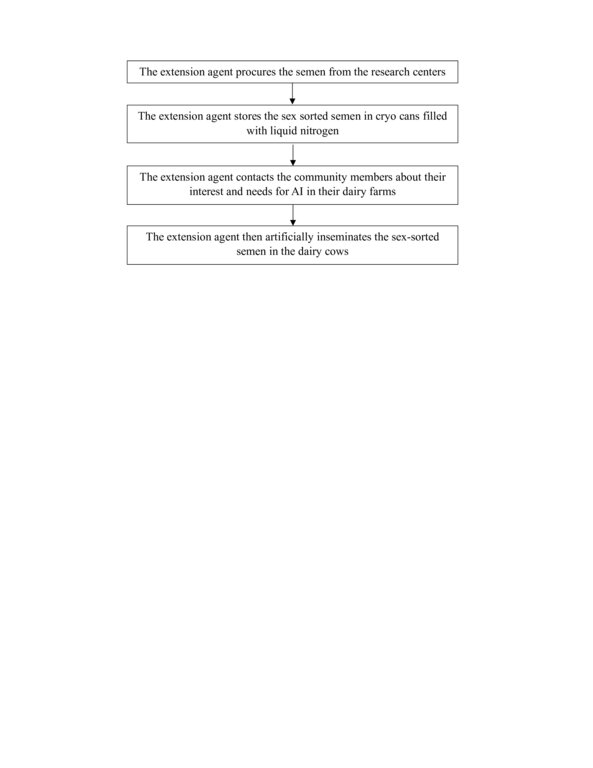Sexed semen technology [不丹]
- 创建:
- 更新:
- 编制者: ONGPO LEPCHA
- 编辑者: Kuenzang Nima
- 审查者: William Critchley, Rima Mekdaschi Studer
Pho mo akha chi yaedpai khab saen gi thrilrig
technologies_6823 - 不丹
查看章节
全部展开 全部收起1. 一般信息
1.2 参与该技术评估和文件编制的资源人员和机构的联系方式
关键资源人
土地使用者:
Pem Tenzin
Tshangkha village
不丹
有助于对技术进行记录/评估的项目名称(如相关)
Strengthening national-level institutional and professional capacities of country Parties towards enhanced UNCCD monitoring and reporting – GEF 7 EA Umbrella II (GEF 7 UNCCD Enabling Activities_Umbrella II)有助于对技术进行记录/评估的机构名称(如相关)
National Soil Services Centre, Department of Agriculture, Ministry of Agriculture & Livestock (NSSC) - 不丹1.3 关于使用通过WOCAT记录的数据的条件
编制者和关键资源人员接受有关使用通过WOCAT记录数据的条件。:
是
1.4 所述技术的可持续性声明
这里所描述的技术在土地退化方面是否存在问题,导致无法被认为是一种可持续的土地管理技术?:
否
注释:
The technology is not directly related to land degradation. However, it contribute to sustainable land management practices, as adoption of sexed semen technology pre-determines sex of calf in favor of female progeny (about 90% female and 10% male) that demands good management practices such as development of improved pasture, and improved dairy sheds.
2. SLM技术的说明
2.1 技术简介
技术定义:
Sexed semen technology produces gender-selected semen for artificially insemination of dairy cows. It ensures a higher proportion of female calves (more than 90%) which will ultimately contribute to the enhancement of milk production in the herd.
2.2 技术的详细说明
说明:
The Artificial Insemination (AI) program, initiated in 1987, has helped AI evolve into a widespread practice for dairy farms across Bhutan, with increasing accessibility due to improved road and transportation networks. The surge in demand for dairy products has positioned AI technology as key in transforming dairy farms from subsistence to market-oriented production systems.
A recent addition to the programme is the use of sexed semen, meaning sorting of semen before artificial insemination. Semen sorting involves categorizing bull semen based on the X and Y chromosomes, thus granting dairy land users control over calf gender. This empowers them to engage in selective breeding, enhancing desired traits and overall quality of dairy production.
Several key activities are integral to this technology:
•Rigorous selection of bulls with desirable traits related to milk production and overall health.
•Collection and preservation of semen from selected bulls.
•Semen sorting technology to separate X and Y chromosome-bearing sperm.
•Artificial insemination of dairy cows by extension agents who use sorted semen.
The benefits are multiple because achieving a higher proportion of heifer calves helps dairy land users to enhance breeding strategies and maintain desired traits within the herd. Economic benefits follow through increased dairy production and improved cattle health.
Land users express satisfaction with the technology and its impact. However, some households report problems with conception rates after AI with sexed semen. Despite these drawbacks, the overall benefits to dairy land users and the industry outweigh the limitations.
2.3 技术照片
2.5 已应用该技术的、本评估所涵盖的国家/地区/地点
国家:
不丹
区域/州/省:
Trongsa
有关地点的进一步说明:
Tshangkha, Tangsibji
具体说明该技术的分布:
- 适用于特定场所/集中在较小区域
技术现场是否位于永久保护区?:
否
Map
×2.6 实施日期
如果不知道确切的年份,请说明大概的日期:
- 10-50年前
2.7 技术介绍
详细说明该技术是如何引入的:
- 通过项目/外部干预
注释(项目类型等):
The technology was introduced by the Department of Livestock to increase the likelihood of birthing female cattle and enhance milk production across the country.
3. SLM技术的分类
3.1 该技术的主要目的
- 改良生产
- 减少、预防、恢复土地退化
- 保持/提高生物多样性
- 创造有益的经济影响
- Improves dairy production
3.2 应用该技术的当前土地利用类型
同一土地单元内混合使用的土地::
否

农田
- 一年一作
年作 - 具体指明作物:
- 谷物类 - 玉米
- 谷类 - 小麦(春季)
- 根/块茎作物 - 土豆
- 蔬菜 - 叶菜(色拉、卷心菜、菠菜和其他)
- 蔬菜 - 根茎类蔬菜(胡萝卜、洋葱、甜菜等)
每年的生长季节数:
- 1
采用间作制度了吗?:
否
采用轮作制度了吗?:
是
如果是,请具体说明:
The crop rotation is normally done with the crops listed above, after the growing season of each crops.

牧场
集约放牧/饲料生产:
- 收割和携带/零放牧
- 改良牧场
动物类型:
- 牛 - 奶制品
注释:
The land is where the manure of the dairy cattles are applied on.
3.3 由于技术的实施,土地使用是否发生了变化?
由于技术的实施,土地使用是否发生了变化?:
- 否(继续问题3.4)
3.4 供水
该技术所应用土地的供水:
- 混合雨水灌溉
注释:
The irrigation is mostly rainfed; however, the availability of water in the community is not an issue.
3.5 该技术所属的SLM组
- 农畜综合管理
- 改良植物品种/动物品种
3.6 包含该技术的可持续土地管理措施

农艺措施
- A1:植被和土壤覆盖层
- A2:有机质/土壤肥力
3.7 该技术强调的主要土地退化类型

生物性退化
- Bc:植被覆盖的减少
- Bl:土壤寿命损失

其它
具体说明:
There is very minimal land degradation.
注释:
The technology was implemented to address dairy production however, it also contributed to reduced land degradation because many land users have opted for improved dairy cattle by replacing local breeds which were numerous and unproductive.
3.8 防止、减少或恢复土地退化
具体数量名该技术与土地退化有关的目标:
- 不适用
注释:
This technology is aimed to improve genetic of cattle breed to enhanced dairy production and reduce unproductive cattle population. However, the technology has indirect benefits on sustainable land management through the application of manures, improved housing and pasture development
4. 技术规范、实施活动、投入和成本
4.1 该技术的技术图纸
技术规范(与技术图纸相关):
Since sexed semen technology was not directly established in the community members, the product of the technology was used in the field through AI. Therefore, a flow chart of how the technology is implemented in the field was not created
作者:
Palden Wangchuk Dorji
日期:
07/07/2023
4.2 有关投入和成本计算的一般信息
具体说明成本和投入是如何计算的:
- 每个技术单元
指定单位:
Number
指定单位面积(如相关):
AI straw
其它/国家货币(具体说明):
Ngultrum
如相关,注明美元与当地货币的汇率(例如1美元=79.9巴西雷亚尔):1美元=:
79.62
注明雇用劳工的每日平均工资成本:
600
4.3 技术建立活动
| 活动 | 时间(季度) | |
|---|---|---|
| 1. | Procurement of sexed semen | Based on indent or the annual requirement at National level |
| 2. | Storage of sexed semen | After procurement until distributed to dzongkhags at Central level |
| 3. | Transportation and Distribution of sexed semen | As per schedule, every 45 days |
| 4. | Storage of semen | semen bank at Veterinary Hospital and AI centre on regular basis |
| 5. | Render Artificial insemination services to farmers by AI technician | Based on request of farmers reporting on animal showing heat signs |
| 6. | Follow up on AI services (monitoring) | 18-22 days, repeat case, monthly report, ad hoc through phone call |
4.4 技术建立所需要的费用和投入
| 对投入进行具体说明 | 单位 | 数量 | 单位成本 | 每项投入的总成本 | 土地使用者承担的成本% | |
|---|---|---|---|---|---|---|
| 劳动力 | Community AI Technician | person/Day | 2.0 | 1000.0 | 2000.0 | |
| 设备 | Sexed semen AI | per straw | 1.0 | 1500.0 | 1500.0 | |
| 设备 | golves | No | 1.0 | 5.0 | 5.0 | |
| 设备 | AI sheath | No | 1.0 | 16.0 | 16.0 | |
| 设备 | LN2 | litre | 300.0 | 35.0 | 10500.0 | |
| 设备 | LN2 container (55 litre) | No | 2.0 | 25050.0 | 50100.0 | |
| 设备 | Portable AI container (5 litres) | No | 1.0 | 11200.0 | 11200.0 | |
| 设备 | Water boiler (3 litres) | No | 1.0 | 2800.0 | 2800.0 | |
| 设备 | Jug | No | 1.0 | 30.0 | 30.0 | |
| 植物材料 | Funnel | No | 1.0 | 150.0 | 150.0 | |
| 植物材料 | Towel | No | 1.0 | 100.0 | 100.0 | |
| 植物材料 | Flexible Dip stick | No | 1.0 | 2500.0 | 2500.0 | |
| 施工材料 | AI crates | No | 1.0 | 45000.0 | 45000.0 | |
| 其它 | Travel | km | 15.0 | 30.0 | 450.0 | |
| 技术建立所需总成本 | 126351.0 | |||||
| 技术建立总成本,美元 | 1586.93 | |||||
如果土地使用者负担的费用少于100%,请注明由谁负担其余费用:
The cost is normally covered by the Royal Government of Bhutan
注释:
The cost is based on conducting AI for a single dairy cow
4.5 维护/经常性活动
| 活动 | 时间/频率 | |
|---|---|---|
| 1. | Storage of the sex sorted semen | When the semen is procured by the extension agent and before conducting AI |
4.6 维护/经常性活动所需要的费用和投入(每年)
如果土地使用者负担的费用少于100%,请注明由谁负担其余费用:
The cost is mostly covered by the Royal Government of Bhutan
注释:
The only maintenance regarding this technology is the storage of the AI straw filled with sex-sorted semen in cryocan filled with liquid nitrogen. The cost is also based on a single AI straw.
4.7 影响成本的最重要因素
描述影响成本的最决定性因素:
Material cost, heat detection, distance
5. 自然和人文环境
5.1 气候
年降雨量
- < 250毫米
- 251-500毫米
- 501-750毫米
- 751-1,000毫米
- 1,001-1,500毫米
- 1,501-2,000毫米
- 2,001-3,000毫米
- 3,001-4,000毫米
- > 4,000毫米
指定年平均降雨量(若已知),单位为mm:
100.00
有关降雨的规范/注释:
The data was used from the National Center for Hydrology and Meteorology from the nearest weather station.
注明所考虑的参考气象站名称:
https://www.nchm.gov.bt/home/pageMenu/906
农业气候带
- 半湿润
Warm Temperate zone
5.2 地形
平均坡度:
- 水平(0-2%)
- 缓降(3-5%)
- 平缓(6-10%)
- 滚坡(11-15%)
- 崎岖(16-30%)
- 陡峭(31-60%)
- 非常陡峭(>60%)
地形:
- 高原/平原
- 山脊
- 山坡
- 山地斜坡
- 麓坡
- 谷底
垂直分布带:
- 0-100 m a.s.l.
- 101-500 m a.s.l.
- 501-1,000 m a.s.l.
- 1,001-1,500 m a.s.l.
- 1,501-2,000 m a.s.l.
- 2,001-2,500 m a.s.l.
- 2,501-3,000 m a.s.l.
- 3,001-4,000 m a.s.l.
- > 4,000 m a.s.l.
5.3 土壤
平均土层深度:
- 非常浅(0-20厘米)
- 浅(21-50厘米)
- 中等深度(51-80厘米)
- 深(81-120厘米)
- 非常深(> 120厘米)
土壤质地(表土):
- 粗粒/轻(砂质)
表土有机质:
- 高(>3%)
5.4 水资源可用性和质量
地表水的可用性:
好
水质(未处理):
良好饮用水
水质请参考::
地表水
水的盐度有问题吗?:
否
该区域正在发生洪水吗?:
否
关于水质和水量的注释和进一步规范:
In accordance with the land users, the quantity of water is more than enough and the quality of the water is also very good compared to the past.
5.5 生物多样性
物种多样性:
- 高
栖息地多样性:
- 高
关于生物多样性的注释和进一步规范:
Since the land user practices crop rotation and grows different types of crops throughout the year, the species diversity is high.
Less forest grazing because land users have replaced unproductive local breeds with improved breeds like Jersey, Holstein Friesian, or cross breeds.
5.6 应用该技术的土地使用者的特征
定栖或游牧:
- 定栖的
生产系统的市场定位:
- 生计(自给)
非农收入:
- 低于全部收入的10%
相对财富水平:
- 平均水平
个人或集体:
- 个人/家庭
机械化水平:
- 机械化/电动
性别:
- 女人
土地使用者的年龄:
- 中年人
5.7 应用该技术的土地使用者使用的平均土地面积
- < 0.5 公顷
- 0.5-1 公顷
- 1-2 公顷
- 2-5公顷
- 5-15公顷
- 15-50公顷
- 50-100公顷
- 100-500公顷
- 500-1,000公顷
- 1,000-10,000公顷
- > 10,000公顷
这被认为是小规模、中规模还是大规模的(参照当地实际情况)?:
- 中等规模的
注释:
Total land owned: 5 acres
Total cultivated land: 1 acre
Remaining lands were either fallow and some of areas of the land were used as pasture land for their cattle to graze.
5.8 土地所有权、土地使用权和水使用权
土地所有权:
- 个人,有命名
土地使用权:
- 个人
用水权:
- 自由进入(无组织)
土地使用权是否基于传统的法律制度?:
是
具体说明:
The traditional legal system in our country is as per the land act and rules and regulations which dictate the land use in the country.
5.9 进入服务和基础设施的通道
健康:
- 贫瘠
- 适度的
- 好
教育:
- 贫瘠
- 适度的
- 好
技术援助:
- 贫瘠
- 适度的
- 好
就业(例如非农):
- 贫瘠
- 适度的
- 好
市场:
- 贫瘠
- 适度的
- 好
能源:
- 贫瘠
- 适度的
- 好
道路和交通:
- 贫瘠
- 适度的
- 好
饮用水和卫生设施:
- 贫瘠
- 适度的
- 好
金融服务:
- 贫瘠
- 适度的
- 好
6. 影响和结论性说明
6.1 该技术的现场影响
社会经济效应
生产
饲料生产
SLM之前的数量:
The cattle were normally grazed in the forest, so no fodder were produced.
SLM之后的数量:
Some of the land that were left fallowed were used for fodder production.
饲料质量
SLM之前的数量:
Local cattles can feed on wild fodder grasses and trees
SLM之后的数量:
Improved cattles require quality fodder so they started growing improved fodders species like Super Napier grass, Napier grass, etc.
畜牧生产
SLM之前的数量:
5 liters of milk were produced from each dairy cow every day
SLM之后的数量:
15 liters of milk are produced by each dairy cow everyday
注释/具体说明:
The quantification was based on the amount of milk produced.
生产区域
SLM之前的数量:
5 acres of cultivated land
SLM之后的数量:
1 acre of cultivated land
注释/具体说明:
The land user now focuses mostly on dairy production and has converted some of the lands into pasture for grazing purposes while the rest has been left fallow. This is due to the absence of labour in the household.
收入和成本
农业投入费用
注释/具体说明:
This is due to the decrease in the cultivated land.
农业收入
注释/具体说明:
Due to the increase in dairy production, the land user is greatly benefited from it.
工作量
注释/具体说明:
Since the land user focuses primarily on dairy, the amount of workload has relatively increased compared to the past, where she would only focus on agriculture, only.
社会文化影响
食品安全/自给自足
SLM之前的数量:
Mostly consumed food they produced in their household.
SLM之后的数量:
Diverse food products are available, together with dairy products.
生态影响
生物多样性:植被、动物
植物多样性
SLM之前的数量:
Maize, wheat and potatoes were the only primary crops grown.
SLM之后的数量:
Maize, wheat, potatoes and several other cole crops and legumes are now cultivated by the land users.
6.2 该技术的场外影响已经显现
温室气体的影响
SLM之前的数量:
more than 30 cattles including dairy cows and bulls
SLM之后的数量:
around 15 dairy cows
注释/具体说明:
There is decrease in the number of cattle and they are mostly female.
6.3 技术对渐变气候以及与气候相关的极端情况/灾害的暴露和敏感性(土地使用者认为的极端情况/灾害)
渐变气候
渐变气候
| 季节 | 增加或减少 | 该技术是如何应对的? | |
|---|---|---|---|
| 年温度 | 增加 | 好 | |
| 年降雨量 | 减少 | 好 |
气候有关的极端情况(灾害)
气象灾害
| 该技术是如何应对的? | |
|---|---|
| 局地暴雨 | 好 |
| 局地雷暴 | 好 |
| 局地雹灾 | 好 |
生物灾害
| 该技术是如何应对的? | |
|---|---|
| 流行病 | 适度 |
| 昆虫/蠕虫侵扰 | 适度 |
注释:
This rating is based on the cattle produced by the technology since the technology itself is not impacted greatly by the change in climate and weather.
6.4 成本效益分析
技术收益与技术建立成本相比如何(从土地使用者的角度看)?
短期回报:
积极
长期回报:
积极
注释:
The benefits of the technology are very high. The recurrent cost of AI is very low as it is provided for free by the Royal Government of Bhutan.
The land users also get the desired sex of the cattle they want (female cattle).
The return they get from improved cattle is very high(high milk yield).
6.5 技术采用
- > 50%
如若可行,进行量化(住户数量和/或覆盖面积):
28 households
在所有采用这项技术的人当中,有多少人是自发的,即未获得任何物质奖励/付款?:
- 0-10%
注释:
The technology can only be implemented by the extension agent since the sexed semen is only procured by them and artificial insemination is also done by the extension agent.
6.6 适应
最近是否对该技术进行了修改以适应不断变化的条件?:
否
6.7 该技术的优点/长处/机会
| 土地使用者眼中的长处/优势/机会 |
|---|
| Produces desirable traits of offspring |
| Improved breed quality |
| Enhances dairy production |
| Produces female cattle |
| Manure from the cattle is used for revitalising the farmland. |
| 编制者或其他关键资源人员认为的长处/优势/机会 |
|---|
| It helps improve the land users livelihood by benefiting them economically. |
| Sexed semen technology produces desired sex cattle which also reduces the recurrent cost of doing AI again and again to get desired sex cattle. |
| Sexed semen technology can ultimately reduce number of unproductive cow which can reduce land degradation and reduce greenhouse gas emmission. |
6.8 技术的弱点/缺点/风险及其克服方法
| 土地使用者认为的弱点/缺点/风险 | 如何克服它们? |
|---|---|
| Sometimes the cattle do not conceive even after insemination. | The possibility of a cow not conceiving after an AI is very low, but it is recommended that the land user consult with the livestock agent or conduct AI again. |
| 编制者或其他关键资源人员认为的弱点/缺点/风险 | 如何克服它们? |
|---|---|
| Sexed semen technology reduces the male population, getting quality breeding bull will be difficult in future. | Allow the dairy cow to mate naturally once in their lifetime |
| Semen produced from the technology may become ineffective during the sorting procedure. | Follow appropriate procedures and double-check equipment. |
7. 参考和链接
7.1 信息的方法/来源
- 实地考察、实地调查
One household
- 与土地使用者的访谈
One individual
(现场)数据是什么时候汇编的?:
07/07/2023
7.2 参考可用出版物
标题、作者、年份、ISBN:
Guar et al. (2021). Sex Sorted Semen -Methods, Constraints and Future Perspective. Veterinary Research International, 8, 368-375.
可以从哪里获得?成本如何?
https://www.researchgate.net/publication/354631046_Sex_Sorted_Semen_-Methods_Constraints_and_Future_Perspective
标题、作者、年份、ISBN:
Singh et al. (2019). Sexed semen technology in cattle: A revolutionary technique in Indian dairy industry. 9, 946-950
可以从哪里获得?成本如何?
https://www.researchgate.net/publication/337919029_Sexed_semen_technology_in_cattle_A_revolutionary_technique_in_Indian_dairy_industry/citation/download
标题、作者、年份、ISBN:
Department of Animal Husbandry and Dauty. (2020). Accelerated Breed Improvement Programme -Using sex sorted semen for getting assured pregnancy. Govt. India
可以从哪里获得?成本如何?
https://dahd.nic.in/sites/default/filess/Guidelines%20for%20sex%20sorted%20semen%20v3.pdf
标题、作者、年份、ISBN:
Butler et al. (2015). The importance of recording in establishing the value of sexed semen to dairy farmers. The Irish Agriculture and Food Development Authority
可以从哪里获得?成本如何?
https://www.icar.org/wp-content/uploads/2015/09/A2-Butler_PPT.pdf
标题、作者、年份、ISBN:
Kumar et al. (2017). Sexed Semen Technology in Cattle. Indian Journal of Animal Health, 56(2), 157-168.
可以从哪里获得?成本如何?
http://ijah.in/upload/snippet/145_53.pdf
标题、作者、年份、ISBN:
Tshering, L. & Tamang, N. B. (2018). Decades of Artificial Insemination: Bittersweet Experiences on Cattle Breeding in Bhutan. Bhutan Journal of Animal Sciences, 2(1), 1-6.
可以从哪里获得?成本如何?
https://www.researchgate.net/publication/353317476_DECADES_OF_ARTIFICIAL_INSEMINATION_BITTERSWEET_EXPERIENCES_ON_CATTLE_BREEDING_IN_BHUTAN
7.3 链接到网络上的相关信息
标题/说明:
TASHI: The First Woman Community AI Technician in the East. /Dzongkha language/
URL:
https://www.youtube.com/watch?v=gk_iXm94ZQQ
标题/说明:
Koufouku International Limited - A Link in the Dairy Value Chain in the East
URL:
https://www.youtube.com/watch?v=JLB_3fdz3ag
链接和模块
全部展开 全部收起链接
无链接
模块
无模块


